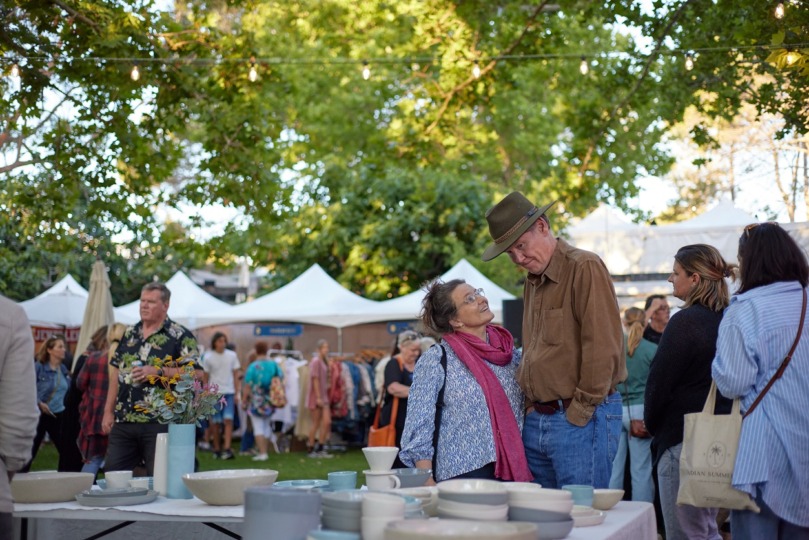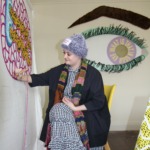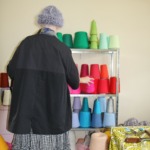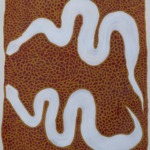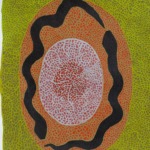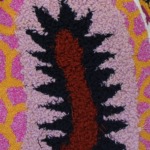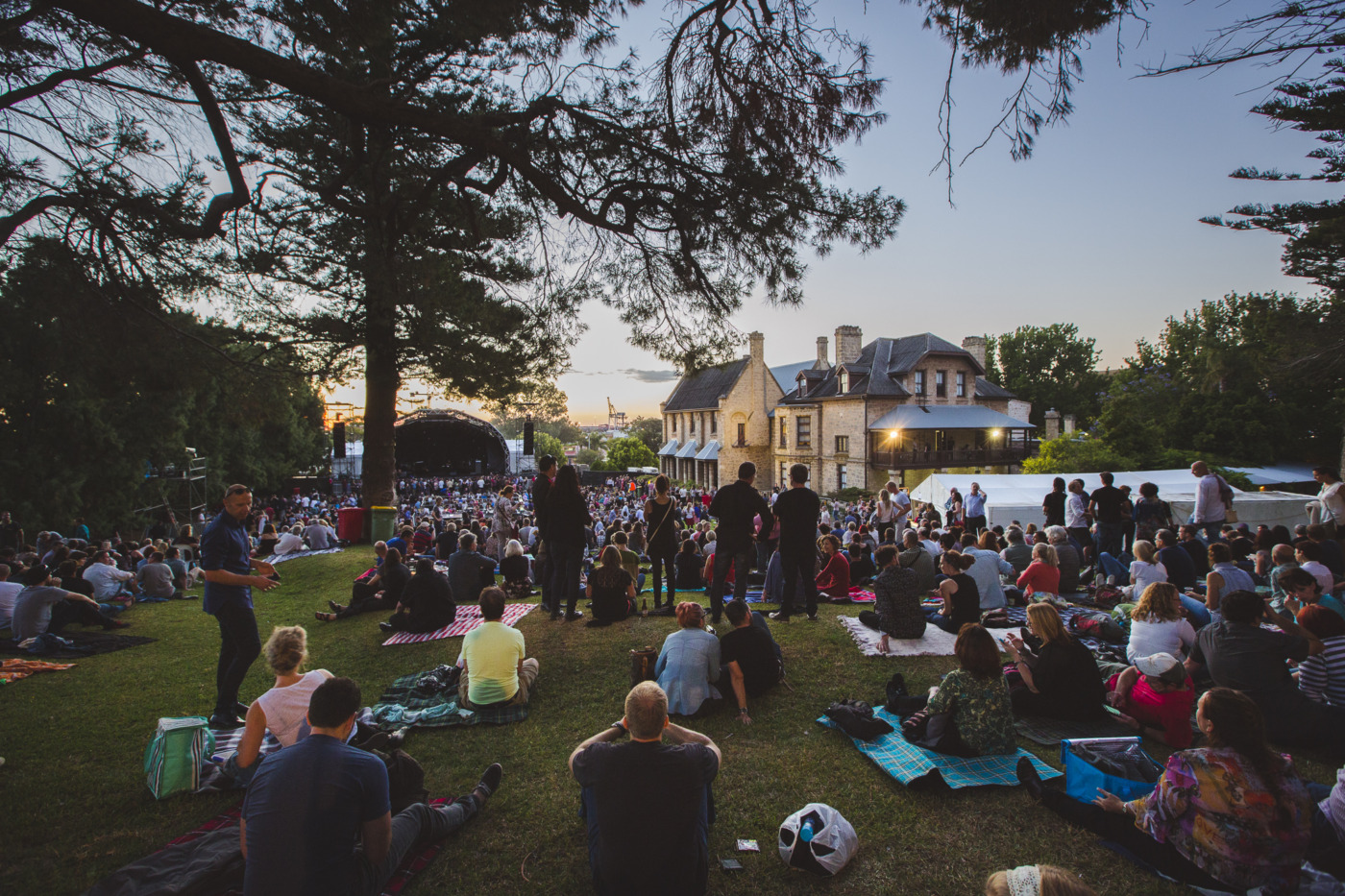Walyalup (Fremantle): Bazaar, WA’s most loved Christmas makers market, returns to FAC from Friday 2 – Sunday 4 December, featuring an extraordinary array of handcrafted homewares, fashion, textiles, jewellery and design from local makers.
Set over three days in FAC’s picturesque grounds, the annual shopping extravaganza presents the highest calibre of WA-designed wares, with 50 extraordinary makers selected from a highly competitive field of applicants.
From hand-dyed silk scarves to organic perfumes and handcrafted wooden kitchenware made right here in Fremantle, Bazaar is the perfect place to pick up quality one-of-a-kind gifts for your loved ones this Christmas.
While browsing the stalls under the beautiful plane trees in our Front Garden, visitors can soak up the vibrant festive spirit with workshops, live music and a smorgasbord of delicious food and refreshments from our food vendors, open all weekend.
Fremantle Arts Centre Director, Anna Reece, says,“A feast of craft and community that is bursting with creative pride, Bazaar is so much more than a market, but a chance for people to come together, to enjoy festive music, food and drinks and to savour this special time of year that is all about giving.”
“What sets Bazaar apart is our commitment to curating a line-up the highest quality local craftspeople, so visitors can explore WA’s best handmade products all in the one location, and rest assured they are purchasing premium, one-of-a-kind gifts that will be treasured for years to come.”
Among the incredible line-up of makers on the bill for 2022 are a Nagula Jarndu, a First Nation’s women’s art centre based in Broome who make colourful hand printed clothing, cushion covers, scarves and hats, as well as bright laser cut earrings in the shape of birds, turtles and crocodiles. For stunning handcrafted glassware, you can’t go past Nikked Glass, a local glass blower who creates a range of tumblers, vases, bowls, paper weights and more.
Creative Sistas is a joint stall featuring the paintings of Noongar artist Buffie Corunna and jewellery of Gooniyandi and Gija woman Camilla Sawford, and Elia Balms & Blends, owned by business and life partners Mia and Jane, make natural and eco-friendly body products including fragrances, soaps and deodorants. Lovers of luxury linen will enjoy the designs of Kristin Magrit, a sustainable and ethical womenswear brand offering high quality pieces made from natural fibres.
Continuing Fremantle Arts Centre’s commitment to nurturing the careers of emerging makers, the Bazaar Incubator program supports five craftspeople in the first five years of their practice to participate in the market with subsidised stallholder fees, mentoring and support.
This year’s Bazaar Incubators are Joshua Button Enterprises, a young Aboriginal artist from Broome who writes and illustrates children’s books, Sarah Pownall, who designs wheel-thrown porcelain homewares from her Bayswater studio, Kwongan Wax, known for her hand-dipped and poured beeswax candles, Smooth Ceramics, who creates a range of natural skincare balms packaged in locally handcrafted ceramic pots and Violet Clark Studio, a textile designer specialising in sleep and loungewear in fabrics inspired by Australian plants and flowers.
In the spirit of celebrating the handmade, Bazaar will feature a number of craft workshops where visitors can try their hand at making their own Christmas wreath from scratch or, for the kids, building and decorating clay Christmas ornaments.
There will also be festive performances by celebrated singer-songwriter Natalie Gillespie, carolling by our very own FAC Yeah! Community Choir and, of course, delicious festive bites and refreshments to enjoy from our food vendors.
2022 Stallholders
Andrea Osses Design
Annette Wiguna
Belen Berganza
Black & Dawson
Blue Lawn Designs
Braw Paper Co
Ceramics By Danica & Beste
Happy Lazuly
Claire Townsend Designs
Clay + Humans
Clay Cloth Metal
Creative Sistas
Convict
Dale’s Outback Pantry
Daniel(Ink.)
Deep Earth Ceramics
Elia Balms & Blends
Fleur Schell
Forrest Road Studios
Gather Ceramics
ijewellery
Jewellers & Metalsmiths
Group Of Australia (WA) Inc
Jody Pearl Studio
Joshua Button Enterprises
Kor By Lisa Gardner
Kristin Magrit
Kwongan Wax
The Silverren
Map Journal
Melting Pot Glass Studio
Nagtzaam
Nagula Jarndu
(Salwater Woman)
Native Needle
Nikked Glass
Prints By Bow
Patong – Alison Bullock
Pixel Cat
Sarah Pownall
Semblance
Smooth Ceramics
Susannah Kings–Lynne
Jewellery
Swalõ Ceramics
The Anjelms Project
Tony Docherty
Turner + Turner
Two Stories
Woven Stories Textiles
Violet Clark Studio
Yuniko Studio
Zinongo Studio
For interviews or further information please contact Media Officer Rosamund Brennan via [email protected] or +61 (8) 9432 9565
Walyalup (Fremantle): A cinematic meditation on belonging in contemporary Australia, from enduring First Nations attachments to Country, to those borne of the colonial adventure or more recent diaspora, Other Horizons brings together three independent projects by nationally renowned artists Atong Atem, Hayley Millar Baker and Jasmine Togo-Brisby.
Opening on 3 February as part of Perth Festival, Other Horizons presents a richly layered collection of works offering nuance to discussions around sovereignty, migration and identity—from South Sea Islander artist Jasmine Togo-Brisby’s ambitious new installation representing a slave ship to Atong Atem’s opulent portraits of South Sudanese diaspora, and Gunditjmara and Djabwurrung artist Hayley Millar Baker’s filmic work exploring First Nations spirituality.
Commenting on the exhibition, which ties in with the Festival’s theme of Djinda (Stars), Fremantle Arts Centre Director Anna Reece said, “Humanity has long gazed up to the stars to gain a deeper understanding of ourselves. Exploring the shared skies, seas and stories that connect all Australians, Other Horizons is a powerful and poetic exhibition that speaks to a universal longing for home and the ways we carry home and culture within us.”
“We are honoured to have three of Australia’s most exciting contemporary artists exhibiting at Fremantle Arts Centre for the first time and as part of Perth Festival, with a number of new works among a bold showcase of sculpture, installation, photography and film. Through his exquisite curation Glenn Iseger-Pilkington brings to the surface narratives and ideas which are often rendered invisible in our national consciousness.”
Marking her Western Australian debut, South Sudanese artist Atong Atem is presenting Banksia, a solo exhibition revealing the complex experiences of African diaspora in Australia, from those who travelled, with the first fleet, to more recent migrations, such as those of the artist’s family. Originally commissioned by Rising Festival (Melbourne, 2021), the exhibition features the eponymous Banksia, an opulent filmic work which reflects on relationships to culture, exploring lesser-known history of Australia’s first African migrants as an entry point to a broader discussion around how migrant communities forge new belongings, while always carrying home, culture and kin within. Alongside Banksia, Atem is also showing a series of photographs, drawn from recent bodies of work, which explore the migrant experience from a non-Eurocentric lens and the roles that photographs play in maintaining connection to home and community from faraway places.
Abyss, a solo exhibition of recent works by Australian South Sea Islander artist Jasmine Togo-Brisby, explores South Sea Islander identity and history and interrogates plantation colonisation and slavery within the Australian and Pacific context. Alongside a significant body of existing works including sculpture, photographic and filmic works, Togo-Brisby will presents an ambitious new commission, As Above, So Below, taking over the art centre’s main gallery. Comprised of over 280 plaster-cast Vanuatuan Tamtam drums, which are said to bring forth the voices of ancestors when struck, the work references the painful history of blackbirding—the practice of kidnapping Pacific Islanders for coerced or forced labour on sugar and cotton plantations in Australia—while also highlighting the formation of new cultures and identities in the bellies of slave ships.
Nyctinasty, a recent filmic work by Gunditjmara and Djabwurrung artist Hayley Millar Baker, speaks to spaces between the physical, emotional and spiritual realms, the in-between spaces that First Nations people occupy simultaneously. In the Western Australian premiere of this filmic work, originally commissioned for Ceremony: The 4th National Indigenous Art Triennial (National Gallery of Australia, 2022), Millar-Baker centres female strength and power, employing horror film tropes and challenging notions of female psychosis through purposeful revealing of a strong, open and resilient protagonist, grounded in her own magic and ancestral connection, played by Millar Baker herself.
A series of public programs and events will accompany the exhibition, including Artists in Conversation: Hayley Millar Baker and Jasmine Togo-Brisby, Curator Tours with Glenn Iseger-Pilkington on 25 February, 9 March and 8 April, and a Tactile Tour for people with disabilities on 16 March. Designed especially for children and families, Djinda Waangkiny – The Stars Speak is a special engagement zone running for the duration of the exhibition where visitors can make their own constellations, write a wish, a dream or a memory, and learn more about the great expanse above us and the many different ways we connect to it.
Other Horizons opens at 6:30pm on Friday 3 February and runs daily till Sunday 23 April 2023. Entry is free.
For interviews or further information please contact Media Officer Rosamund Brennan via [email protected] or +61 (8) 9432 9565
Image: Jasmine Togo-Brisby, Passage (detail) 2022, crows wings, stained wood, crows feathers, plexiglass and brass, 174 x 102 x 32cm. Photography by Jim Cullen
With Bazaar 2022 just around the corner, we’ve compiled this handy guide of need-to-know tips and tricks to ensure your day at the market is a successful one. Read on and get excited about WA’s favourite Christmas Makers’ Market, which returns to FAC from 2-4 December.
Entry
Entry is $2 per adult, kids under 12 are free (payable by card or cash).
Card payments A-Okay!
Each stallholder, our front gate and all food vendors are fully equipped with card facilities.
Entry is $2 per adult, kids under 12 are free (payable by card or cash).
Cash payments for products can be processed at reception. Fremantle Arts Centre gift vouchers can also be used at reception.
Parking
Please respect our neighbours and don’t park on the residential streets surrounding FAC. Limited free street parking is available on Finnerty, Ord and Vale Streets. Parking is also available at Fremantle Leisure Centre for a small fee.
Alternatively, take public transport. FAC is a short 10-minute walk from Fremantle train station with several bus routes stopping nearby. Head to the Transperth Journey Planner to find your best route.
ACROD Parking
Fremantle Arts Centre has recently added additional bays inside the precinct for ACROD pass holders. Access to these bays are via our top gate entrance off Finnerty Street and is controlled by Security on event days. Please present your ACROD pass to the security guard on the gate and if we have bays available, we will accommodate you.
BYO shopping bag
While some stallholders have bags available upon purchase, it’s a good idea to bring along your own shopping bag to ensure you get all your goodies home safe and sound.
Check the map!
We have large Bazaar maps positioned across the site to help you find what you might be looking for.
Gift Wrapping Available
Want your gifts beautifully wrapped? We can help! Gift wrapping is available by donation – head to our station in the Front Garden.
Search #FACBazaar on Instagram
Search the #FACBazaar hashtag for a sneak peek at all the amazing products you can expect to find at Bazaar and to follow stallholders you love.
We’d also love you to share your Bazaar experience with us. If you take any pics over the weekend be sure to tag us @fremantleartscentre and #FACBazaar.
Meet the makers
There’s nothing better than buying direct from makers and artisans. Take the time to chat with the people who have made the things you’re coveting. They’d love to tell you more about their range and how their products are made.
Food & Drink Offerings
There will be lots of yummy food to choose from to keep your energy up while you shop. Head to the food court area at the rear of the building to find a selection of delicious meals from an array of food vendors and a fully stocked bar (open from 5pm on Friday and 12pm Sat + Sun).
This year’s food vendors include: Little Loaf, La Paleta, Thien Kim Vietnamese, Pak Catering, Bunga Raya and My Gozleme.
We will also have a water station, so bring your refillable water bottle.
Workshops & Activities
Visitors will be able to get in on the making this year, with a range of craft workshops on offer. Adults can create their own Christmas wreath using native Australian flora with talented local florist Ellie Murray-Yong from Dirt Flora, and kids can create six festive clay Christmas ornaments with celebrated ceramicist and tutor Holly O’Meehan. Enrol now to secure your place!
City of Fremantle’s Buster the Fun Bus
Will be in the inner courtyard all weekend
Entertainment
Browsing the stalls will be made even more fun with the addition of live music throughout the weekend, including fun, festive tunes from DJ Pamika and acoustic sets from Willem Lieftink.
Be sure to pop in and check out MARAWAR-AK| From the West – a series of four exhibitions championing the creativity of Western Australian artists.
Leave your doggo at home
We love dogs but they’re not permitted within FAC grounds.
Treat yourself!
Go on, you deserve it.
Bazaar runs 5-9pm Fri 2 Dec and 9-5pm Sat 3 and Sun 4 Dec
Walyalup (Fremantle): As the Earth’s axis begins its cyclical tilt, ushering in the seasons of Kambarang, Birak and Bunuru, the southern half of the Western Australian coast is struck by cooling winds off the Indian ocean, tracing the topography of the land, carrying with it the many stories that connect us and catching the sails of those who leave, and those who anchor here.
It is this poetic seasonal marker which gave rise to Marawar-ak | From the West: Contemporary Art from Western Australia — a celebration of Western Australian art, our place in the world and the stories borne from this vast state.
Bringing together practitioners working across design, animation, sculpture, drawing and installation, Marawar-ak comprises four independent exhibitions including Still Watching by Anna Louise Richardson & Abdul-Rahman Abdullah, A Gift and a Shadow by Sally Bower, Backtrack by Katie Breckon and The Rin DinDai by Tyrown Waigana.
The exhibitions feature works of art that survey the lands we live upon, explore the ways we make meaning of the world and others that transport us to imaginary worlds. They present stories of regional and remote life, love, family, grief, choice, sacrifice, alongside works that map geography and memory.
According to Glenn Iseger-Pilkington, Curator Visual Arts, “While Fremantle Arts Centre always has our eyes on the national and international art stages, it’s crucial to us as an organisation that we celebrate Western Australian practice; that we nurture, support and amplify the voices of local artists, make meaningful investments in their careers and celebrate our unique histories and realities.”
“Marawar-ak|From the West is testament to this commitment, bringing together a diverse group of emerging and established artists, each with differing connections to Western Australia, to offer rich stories and experiences using their own unique visual languages and creative approaches.”
A collaborative exhibition by Anna Louise Richardson and Abdul-Rahman Abdullah, Still Watching will immerse Fremantle Arts Centre’s main gallery in a darkly psychological landscape that posits the questions who is watching and who is being watched?
Featuring Richardson’s finely detailed charcoal drawings and Abdullah’s striking sculptural installations, both depicting various domestic and wild animals, the exhibition embodies different experiences and perceptions of mutual observation in the natural world. Embracing the magical thinking of childhood, the artists articulate a personal lore, voicing their relationships with other creatures and the mythic qualities of the worlds we occupy.
A Gift and a Shadow by designer Sally Bower transforms the gallery into “an exhibition-come-agility-course, come-game show”, with soft sculpture, drawing, painting and provocation. Curated by FAC Exhibitions and Engagement Coordinator Emma Buswell, A Gift and A Shadow explores choice and consequence, the road less travelled and the absurdity of life, creating space to consider alternate understandings and interpretations of the world around us.
“Western Australia has a thriving community of designers and makers, but design often flies under the radar of major galleries and institutions,” says Emma Buswell. “A Gift and A Shadow sees the talents of Sally Bower celebrated in her first solo exhibition, a significant career milestone for this skilled designer and artist.”
Katie Breckon is an Aotearoa-born artist, educator and remote community arts worker whose practice explores the transient and transformative notion of home and questions one’s place in the natural world. In Backtrack, Breckon explores expanded drawing and mark-making practices through the lens of mapping personal and physical geographies.
Having lived, worked and travelled, as a visitor on Nyikina, Ngarinyin, and Worrorra Country in the West Kimberley region of Western Australia for a decade, Backtrack acts as an abstracted record of that time, retracing landmarks and mapping journeys in the creation of an archive that renders memory as an act of reflective catharsis.
Walyalup-based artist Tyrown Waigana explores sacrifice and reward and notions of the unexpected in The RinDin Dai a newly commissioned exhibition which plunges audiences into the world of the Hongels, an other-worldly species on their ceremonial day of the RinDin Dai.
Featuring animation, painting and sculpture, The RinDin Dai is Waigana’s first solo presentation at Fremantle Arts Centre, following his inclusion in group exhibitions at FAC including Hundreds & Thousands, A Forest of Hooks and Nails and Revealed: New and Emerging WA Aboriginal Artists.
A series of public programs and events will accompany the exhibition, including Artist Talks on Sat 5 Nov, Curator Tours on 26 Nov and 13 Jan, and a special panel discussion on Western Australian arts practice in Disclosure: Art Today in WA on 13 Dec.
Marawar-ak | From the West: Contemporary Art from Western Australia opens at 6:30pm on Fri 4 Nov and runs daily till Sun 22 Jan 2023. Entry is free.
For interviews or further information please contact Media Officer Rosamund Brennan via [email protected] or +61 (8) 9432 9565
From indie darlings to Indigenous storytellers, queer electro pop to West Coast rock royalty, Fremantle Arts Centre’s Sunday Music season is back for summer—treating music lovers to our most culturally and musically diverse line-up in the program’s history.
This free weekly live music series returns on Sun 2 Oct, kicking off an epic 6-month summer season which sees musical talent from across Australia take the stage in Fremantle Arts Centre’s lush, shady Front Garden setting.
Fremantle Arts Centre’s Director Anna Reece commented, “Born of a love of community, creative exchange and connection, Sunday Music has become a staple in the Port City’s music scene, offering a tastemaking showcase of the most exciting acts.”
“Fremantle Arts Centre lives and breathes new music, and we are proud to support a program overflowing with talented music makers from across the creative spectrum which crosses various genres, identities and cultures, showcasing the unique and diverse community of voices that live and create within our state, and further afield.”
Among the highlights, on 12 February Melbourne-based nine-piece band Ausecuma Beats will grace the Sunday Music stage. Comprised of musicians from Senegal, Mali, Cuba and Guinea, the ensemble is known for fusing their diverse influences into complex rhythms which inspire your body to move, offering something incredibly danceable yet unmistakably unique.
Presented in association with Nannup Music Festival, on 5 March we’re joined by The Krui3ers, who hail from the Mowanjum Community in the Kimberley. Descendants of the renowned Mowanjum band Gulingi Nunga, the fourpiece band employ a high energy country rock style to tell stories of their Country and their old people.
Armed with their motto “the people must dance”, The Bambuseae Rhythm Section is sure to get the crowd moving on 19 February. This energetic six-piece act from Fremantle offer up retro-futuristic psych-funk with a dash of blues rock lyricism, and plenty of attitude to boot.
A visionary First Nations singer-songwriter and producer hailing from the Wardandi Bibbulmun tribe of the southwest of WA, Boox Kid is bringing his unique brand of electro pop to Sunday Music on 11 December. And on 22 January, Australian rock and roll legends Rob Snarksi & Lindy Morrison – of The Blackeyed Susans and The Go-Betweens – are joining forces to showcase their post-punk musical chops, in a show described as “not for the faint hearted, but for the romantic, the readers, the writers, the lovers and the lost.”
Also joining the line-up is Siobhan Cotchin (29 January), who’ll mesmerise audiences with her jangly luminous melodies, Natalie Gillespie (9 October), one of Perth’s most soulful singer/songwriters and the leader of FAC Yeah! Community Choir and Priscilla (11 December), a Boorloo based synth-pop duo, described by Purple Sneakers as “the electro-pop sound of the future”.
Sunday Music runs 2 October 2022 to 26 March 2023 from 2pm – 4pm in the Front Garden at Fremantle Arts Centre. This free, family friendly event has limited capacity, so we recommend guests arrive early and settle in for the afternoon. Bring a rug and picnic (no BYO alcohol) or enjoy tasty treats from the food vendors and bar on-site.
2022-23 Sunday Music Line-Up
2 October Queency + The Liquid Project
9 October Natalie Gillespie + Sgt Hulka
16 October Natasha Eldridge + Clive Morrison & The Lost Boys
23 October Drea + Princess Khanya
6 November De Cuba Son + TAB Family & Friends
13 November Catherine Traicos + Romy B
20 November Artemis Orchestra
27 November Lincoln Mackinnon + Dolce Blue
11 December Priscilla + Boox Kid
18 December Endeavourous + Odlaw
8 January Anna Schneider + Jocelyn’s Baby
15 January GIA COMO + Buckland
22 January Rob Snarski & Lindy Morrison
29 January Siobhan Cotchin + Mia June
5 February Mal de Mer + Heathcote Blue
12 February Music in Exile presents: Ausecuma Beats
19 February The Bambuseae Rhythm Section
5 March Nannup Festival presents: The Krui3ers + Nelson O’Reeri
12 March Big Orange + The Mackerels
19 March The Washing Line Economy + Jacob Wylde
26 March Web Rumors ex Machina + Timothy Nelson
For interviews or further information please contact Media Officer Rosamund Brennan via [email protected] or +61 (8) 9432 9565
Opening on Friday 12 August, Tania Ferrier: Pop Porn explores the representation of women in the commodity culture of the 80s—challenging misogynistic gender ideals, giving voice to feminine authority and prompting deeper reflection on how far, or how little, we’ve come in the last forty years.
A City of Fremantle Art Collection exhibition curated by André Lipscombe and Tania Ferrier, Pop Porn features a survey of the artist’s internationally renowned Angry Underwear project alongside a series of new print works and animated videos created in residency at Fremantle Arts Centre in 2021.
Set against the socio-political climate of the #MeToo movement and the policing of women’s bodies with the over-turning of Roe v Wade, the exhibition builds on Tania’s decades-long feminist practice, offering a contemporary lens on issues including violence against women, consent, safety and beauty, as well as the impact of racial stereotypes in porn and mainstream media.
The exhibition will present nine Angry Underwear sets, bras and underwear featuring shark’s teeth and eyes, created after the artist witnessed the assault of ‘Angel’, a Latino stripper that she got to know while working at the Wild Fyre men’s club in New York in the 80s.
Aiming to call out sexual violence in the workplace, the work is an act of empathy for Tania, acknowledging her own experience of sexual assault in childhood. While the garments were banned by the club management, they later gained media attention when sold from a risqué ‘new wave’ fashion outlet and worn by cultural icons Madonna and Naomi Campbell.
“I am interested in creating art that engages people to contemplate the subject and possibly be awakened,” says Fremantle-based artist Tania Ferrier.
“We come to the Pop Porn exhibition bringing with us our own experiences; the relationship we have to our own bodies, to other’s bodies, our personal histories and our up-bringing. We all see differently. And that is ok.”
Tania’s new print and video series are a product of disassembling 1980’s Playboy centrefolds, in order to reframe her own attention to both the objectification of women’s bodies in mainstream porn and taboos about female sexual desire.
Utilising a surrealist, cut and paste imagery tactic, Pop Porn Calendar Series is comprised of twelve large-scale digital prints featuring scanned and processed collages sourced from original Playboy imagery.
Playboy Collage is a video work featuring a timelapse sequence of moving parts cut out from centrefolds which tumble, twirl and transmute like demi-gods across the screen. The resulting images are powerful and erotic, animating the commanding feminine energy embodied in Tania’s practice.
Presented and curated by the City of Fremantle Art Collection, the largest municipal art collection in Western Australia, Pop Porn typifies the collection’s commitment to presenting contemporary exhibitions which respond to pertinent historical moments.
“Humorous and empowering, Pop Porn prompts us to consider the broader cultural forces around the representations of women; the all-white, domesticised goddesses of the American dream which pervaded popular porn in the 80s, and continue to influence our notions of femininity and sexuality today,” said City of Fremantle Art Collection Curator André Lipscombe.
“By shaking up and subverting mainstream image culture, Tania grants women an active role in reimagining the banal ideals of beauty and desire found in pornography and mass media.”
Accompanying the exhibition is a comprehensive catalogue of texts by writers and artists including Tui Raven, Josephine Wilson, Dr Zoe Sofoulis and Noura Kevorkian, engaging with the themes of feminism, identity and the female body found in the exhibition and their own practices.
Tania Ferrier: Pop Porn opens 6:30pm, Friday 12 August alongside A Gentle Misinterpretation: Australian Artists and Chinoiserie and Jila Kujarra: Two Snakes Dreaming. The exhibitions are then open 10am – 5pm daily until Sunday 23 October.
A series of public programs will run in conjunction with the exhibition, including Artist Talk | Jila Kujarra: Two Snakes Dreaming + Tania Ferrier: Pop Porn on Saturday 13 August, and An Evening with the Collection with Tania Ferrier and invited guests, 6:30pm Thursday 22 September.
For interviews or further information please contact Media Officer Rosamund Brennan via [email protected] or +61 (8) 9432 9565
Image: GoGo Girls, New York, 1991. Image courtesy M. Santo
A Boorloo-based visual artist and designer working across textiles and fashion, Mariaan Pugh has teamed up with Martu artist Desmond Taylor to create Jila Kujarra: Two Snakes Dreaming, an exciting cross-cultural collaboration which opens at 6:30pm on Fri 12 Aug.
Taylor and Pugh have worked together to transform Taylor’s Niminjarra paintings, usually seen on canvas or paper, into highly tactile textile works, animating the important Niminjarra Jukurrpa (Dreaming).
The exhibition is the realisation of a long-held vision Taylor, a prolific painter who works with Martumili Artists. It continues the practice of cultural and creative exchange driven by the arts centre in recent years, with the intent of sharing Martu art, language, culture and stories with new national and international audiences.
First of all, can you tell us a little bit about your practice?
Absolutely, so I studied Textiles at Curtin University and then did an Advanced Diploma of Fashion & Textile Design from North Metropolitan TAFE. I primarily work in rug making, embroidery, and weaving. I’m really interested in subverting these traditional textile techniques into more contemporary and unconventional formats. My work tends to be more light-hearted and playful in style, so I’m particularly drawn to vivid colour and motifs, and highly tactile surfaces. I have a studio in Subiaco where I spend a few days a week on my practice, and I also teach fashion & textiles at North Metropolitan TAFE and The Children’s School of Contemporary Art, which I really love.
Tell me, how did the collaboration with Desmond come about?
Erin Coates (former FAC special projects coordinator) worked with Desmond for Revealed in 2018, and during that process she discovered that he wanted to work with someone to make rugs, specifically a Western Australian artist. At this point, I had already been working with rugs for five years and it was really the focus of my art practice. So Erin put me in contact with Desmond and Martumili at the end of 2018, and that’s where it all started. I travelled to Newman to meet with him in 2019 and that’s when he told me the story of Niminjarra and showed me all his paintings and then kind of told me what he wanted.
Was that the first time you’d be up to Parrngurr, where Desmond lives? What was that experience like?
Yeah, it was the first time. It was so amazing. As soon as you get off the plane it’s almost like you have this filter over your eyes because everything is just covered in red dust. It’s absolutely beautiful. He was so lovely and generous with telling me his stories and about his paintings. I felt really honoured to be there and that he made the time to meet me. I’d really love to go back up there and share some of these rug-making techniques with the Martu community as well. He’s also come down to Perth twice during this project. He’s such a busy person but always makes time to catch up. There’s been a lot of phone calls between us as well texts back and forth as the work has developed.
It must be really rewarding to work on this creative project together, and to get to know each other during the process. What has your working relationship with Desmond been like?
It’s been such a joy and privilege to work with Desmond to expand his practice into a new medium. Our working relationship has been easy and natural. He really trusts me creatively and anything I suggest he’s happy for me to do. So I guess I’ve just tried to be really conscientious of staying true to the works as much as I can in terms of colour and patterning, and checking in with him as much as possible.
- Desmond Taylor, Niminjarra (resting), 2020, gouache on paper, 51 x 66cm,
- Desmond Taylor, Niminjarra, 2019, gouache on paper, 50 x 65cm
- Mariaan Pugh, Niminjarra (home camp), 2021, assorted yarn, monks cloth
- Mariaan Pugh, Niminjarra (nyurnma), 2021, assorted yarn, monks cloth
How do you actually go about translating Desmond’s paintings into rugs?
I always start with studying Desmond’s paintings and trying to get a feel for them. When I first started, I realised it’s quite hard to get the finer details of the paintings into the rugs, so I simplified them a bit first. Basically, I trace the outline of the paintings first to replicate them as best I can and then I transfer that onto the fabric where I do the tufting. For the first couple of ones, I was just drawing his paintings freehand, but then I started tracing them as I felt it’s a bit more conscientious doing it this way. Where I can, I colour match the yarn to the painting and create a colour palette for the rug, Desmond has also been happy for me to change colours where suitable. Then I begin the process of rug making, for these works I have used a rug hook, a punch needle and a manual tufting gun. I interchange these techniques depending on the design and to create variation in textures.
Why are you so drawn to rug making? What is it about the medium that you love?
I really love the practice of rug making. I’m a highly tactile person, and yarn is definitely the most tactile medium for me. I always use a wide range of colour and textures, rug making allows me to play and experiment with both of these. It’s so satisfying to see the design come to life, thread by thread. It can take upwards of a week just to complete one rug.
Jila Kujarra: Two Snakes Dreaming opens 6:30pm, Fri 12 Aug alongside A Gentle Misinterpretation: Australian Artists and Chinoiserie and Tania Ferrier: Pop Porn. The exhibitions are then open 10am – 5pm daily until Sunday 23 October.
Opening on Friday 12 August, Jila Kujarra | Two Snakes Dreaming is a dynamic cross-cultural collaboration between Warnman artist Desmond Taylor and Boorloo-based textiles practitioner Mariaan Pugh.
Taylor and Pugh have worked together to transform Taylor’s Niminjarra paintings, usually seen on canvas or paper, into ten large-scale textile works, reanimating the important Niminjarra Jukurrpa (Dreaming).
The exhibition is the realisation of a long-held vision of Taylor’s, a prolific painter who works with Martumili Artists. It continues the practice of cultural and creative exchange driven by the arts centre in recent years, with the intent of sharing Martu art, language, culture and stories with new national and international audiences.
“The idea for the rugs came many years ago when I was looking at different ways of trying to find my own style of artwork and create a pathway for my work,” says Taylor.
“I always wanted to concentrate on one Jukurrpa, one storyline of a Dreaming path that our people are descendants of. Sharing this story is about giving people the opportunity to learn about the first culture that’s been in Australia before settlement.”
- Mariaan Pugh, Niminjarra (nyurnma), 2021, assorted yarn, monks cloth
- Mariaan Pugh, Niminjarra (home camp), 2021, assorted yarn, monks cloth
- Desmond Taylor, Niminjarra, 2019, gouache on paper, 50 x 65cm
- Desmond Taylor, Niminjarra (resting), 2020, gouache on paper, 51 x 66cm,
Desmond’s exquisitely detailed Niminjarra paintings follow the Jukurrpa (Dreaming story) of two brothers, who transform into snakes so they can return home to Ngayartakujarra (Lake Dora), a sacred part of Martu Country.
Made by hand with painstaking precision, Mariaan Pugh has translated Taylor’s paintings into large scale tufted rugs. Displayed side by side in the exhibition, audiences will be wowed by their extraordinary likeness and the incredible craftsmanship of each distinct medium.
“It’s been a joy and a privilege to work with Desmond to expand his practice into an entirely new medium,” says textile artist, fashion
designer and educator Mariaan Pugh.
“Given the cultural significance of his works, I’ve been careful to stay true to his paintings as much as the medium allows, although we’ve had to make a few tweaks here and there.”
“I really love the practice of tufting, it’s a highly tactile medium and it’s so satisfying to see the design come to life, thread by thread. It can take upwards of a week just to complete one rug.”
According to FAC Curator Visual Arts Glenn Iseger-Pilkington, “This exhibition represents the ambition of a Martu artist to tell his Dreaming stories in a way that increases the accessibility and reach of his paintings beyond a canvas.”
“It also demonstrates the importance of fostering cross-cultural collaborations in ways that are ethical and culturally sensitive, that show respect for culture while opening up new income streams and possibilities for First Nations artists.”
Jila Kujarra: Two Snakes Dreaming opens 6:30pm, Friday 12 August alongside A Gentle Misinterpretation: Australian Artists and Chinoiserie and Tania Ferrier: Pop Porn. The exhibitions are then open 10am – 5pm daily until Sunday 23 October.
A series of public programs will run in conjunction with the exhibition, including Artist Talk | Jila Kujarra: Two Snakes Dreaming + Tania Ferrier: Pop Porn on Saturday 13 August. Please visit fac.org.au for more information.
For interviews or further information please contact Media Officer Rosamund Brennan via [email protected] or +61 (8) 9432 9565
Hero image: Mariaan Pugh & Desmond Taylor, Niminjarra, 2022, assorted yarn, monks cloth. © Courtesy the artists. A collaborative project between the artists, Fremantle Arts Centre and Martumili Artists, 2020-22.
Chinoiserie – the Western appropriation of Asian aesthetics – rose to prominence in eighteenth century at a time when the British Empire was exerting extraordinary dominance over the global market; effectively undercutting the original artisans and commodifying meaningful cultural artefacts.
Opening at Fremantle Arts Centre on 12 August, A Gentle Misinterpretation: Australian Artists and Chinoiserie is a contemporary exploration of this problematic practice, presenting thirteen artists whose works reflect on notions of cultural thievery, colonisation, exoticisation, and excess.
Conceived and curated by Andrew Nicholls, the exhibition is the culmination of a seven-year research and development project, including residencies at Brighton’s Royal Pavilion, (the seaside pleasure palace of George IV and the world’s most spectacular remaining example of Chinoiserie architecture), and The Pottery Workshop in Jingdezhen, China.
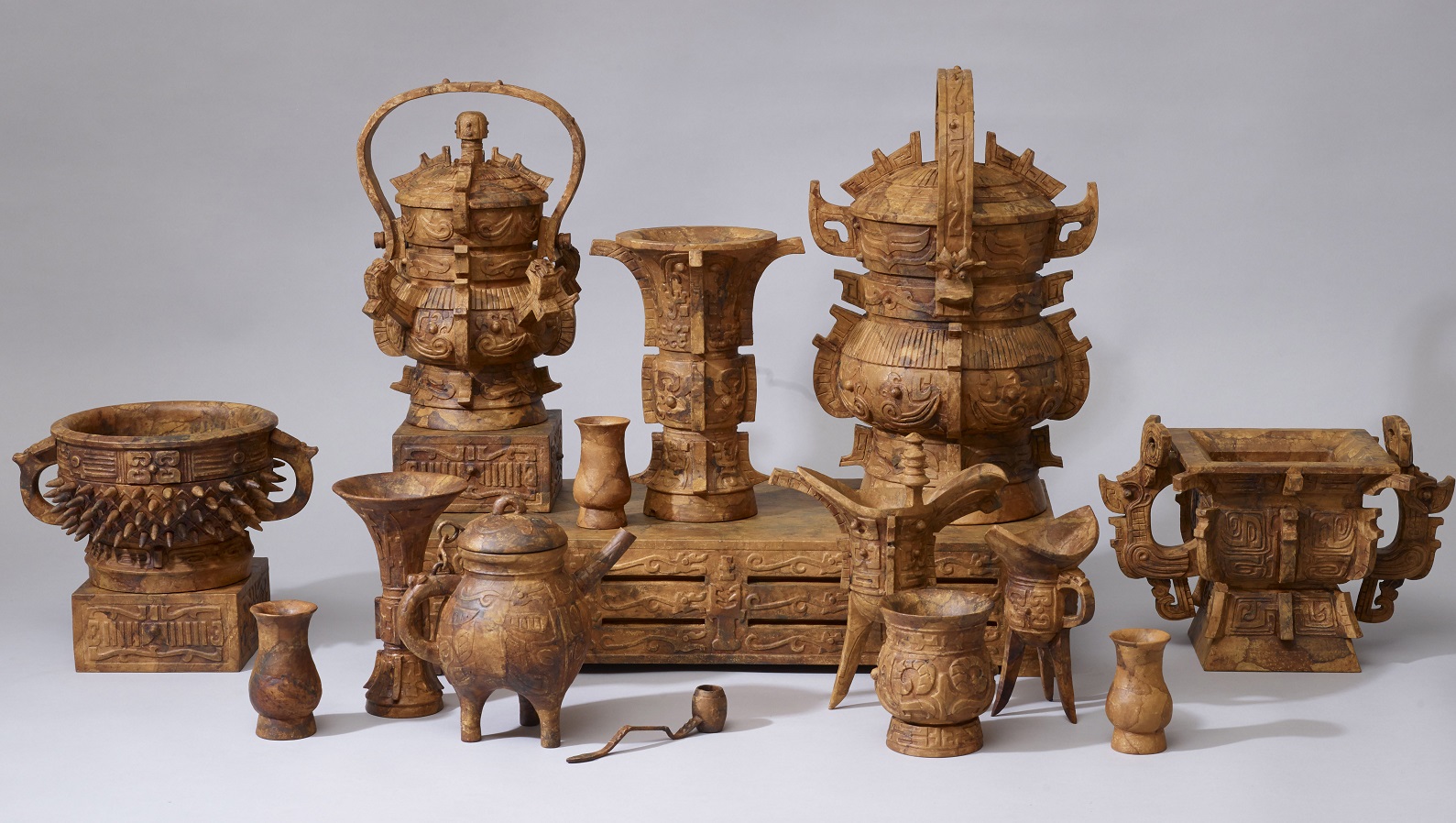
Tanija and Graham Carr, Chinoiserie Group (detail), 2017-2022, leather, stained finish, 170 x 60 x 70cm. Photography by Victor France. Image courtesy the artists
Including several new commissions produced during the residencies alongside existing works, A Gentle Misinterpretation features Abdul Abdullah, Casey Ayres, Nathan Beard, Sandra Black, Tanija and Graham Carr, David Charles Collins, Theo Costantino, Susan Flavell, Tarryn Gill, Pilar Mata Dupont, Cherish Marrington and Andrew Nicholls. The exhibition also includes works produced in collaboration with artists from Jingdezhen, China, residents of Brighton, UK and Perth-based classical music collective HIP Company.
Named after the comments of Robert Copeland, an ancestor of one of the UK’s most iconic China dynasties, who described Chinoiserie as ‘a gentle misinterpretation’ of Chinese culture, the exhibition is an opulent, sensual and comedic exploration of one of Western culture’s most fascinating aesthetic curiosities.
“A Gentle Misinterpretation is a real passion project for me,” says the exhibition’s curator and exhibiting artist Andrew Nicholls. “In my practice, I like to explore antiquated and historical art forms through a contemporary lens, highlighting some of the broader historical context that informs them.”
Varying in medium, scale and approach, the exhibiting artists engage with Chinoiserie from a multitude of angles. Some have referenced the opulence and excess of the Chinoiserie genre and George IV’s notorious decadence, others have interpreted the broader themes of colonialism and cultural thievery, or the nuanced relationships to their own cultural heritage and ties to the region.
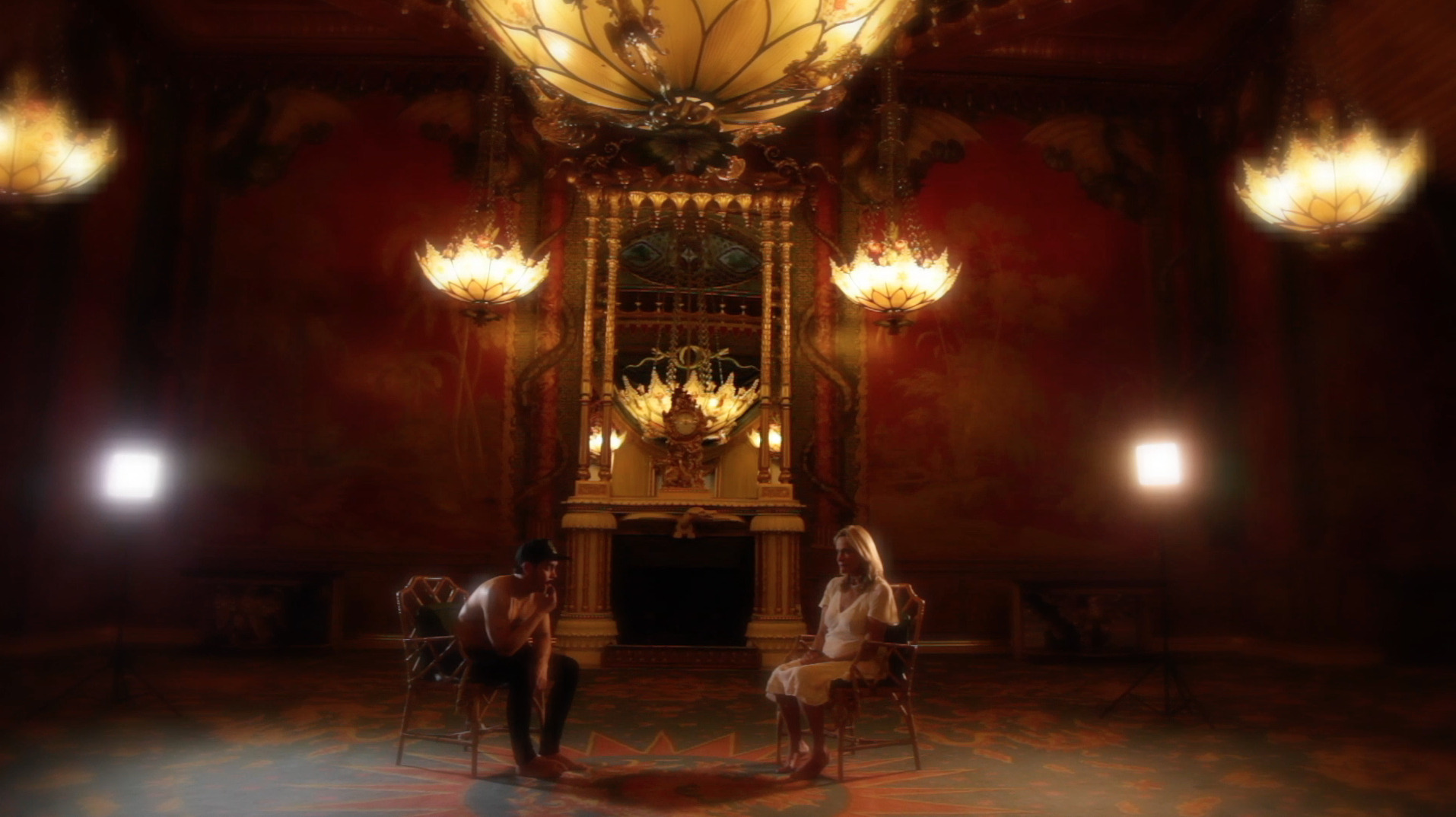
Abdul Abdullah, Dispossessed (detail), 2015, digital video 2 minutes 13 seconds (with credits and soundtrack)
Thai-Australian artist Nathan Beard is exhibiting a series of porcelain vases cast by Jingdezhen artisans and featuring hand-painting by cobalt master Yu Xuan. These collaborative works reinterpret scenes from the Kachin region of Myanmar (a country bordering China and Thailand) in the style of traditional Chinese porcelain art, reflecting multiple layers of cross-cultural and colonial scrutiny.
Shot in the Royal Pavilion’s Music Room, Abdul Abdullah’s lavish video work Dispossession features Abdullah and Brighton-based actress Sidonie Bond, performing a scene from Shakespeare’s The Tempest. Abdullah plays the slave Caliban, a character he has portrayed in numerous self-portraits in recent years, while Bond is Miranda, his oppressor – offering a new lens on this storied power dynamic within a space loaded with imperialist history.
Interrogating George IV’s excessive lifestyle, Tarryn Gill’s Surely This is Death is an installation based upon satirical cartoons mocking George’s penchant for overeating and his taste for the exotic, while Pilar Mata Dupont’s sound installation, which can be encountered throughout the exhibition, draws on correspondence, financial and medical documentation relating to George’s lifestyle, spending and health.
Andrew Nicholls is presenting a series of porcelain objects including A Gentle Misinterpretation, a collection of recycled and repurposed vintage dinnerware. Adorned with Blue Willow – the most enduring example of Chinoiserie, designed in the UK – the works demonstrate the pervasive nature of Britain’s China production, which was so effective that Asian ceramicists were forced to copy the design.
In a nod to George IV’s substantial legacy of arts patronage, the various residency outcomes are complemented by commissioned objects from some of Western Australia’s senior-most craft makers, including Sandra Black and Susan Flavell, and Tanija and Graham Carr, whose works draw inspiration from Asian aesthetics.
According to Glenn Iseger-Pilkington, Curator Visual Arts at Fremantle Arts Centre, “Hidden behind Chinoiserie’s aesthetic charm is a much darker narrative of dispossession and cultural thievery, practices of erasure on which empires are built, and histories are rendered.”
“A generous and insightful exhibition which explores aesthetic legacies, A Gentle Misinterpretation prompts us to question the euro-centric gaze and to remain curious about the provenance of cultural artefacts, symbols and visual languages. The exhibition is a timely reminder that the cultural work we do today leaves a legacy and a narrative for future minds to explore and critique, and to truth-tell around.”
A Gentle Misinterpretation: Australian Artists and Chinoiserie opens 6:30pm Friday 12 August alongside Jila Kujarra: Two Snakes Dreaming and Tania Ferrier: Pop Porn. The exhibitions will be open daily until Sunday 23 October.
A series of public programs will run in conjunction with the exhibition, including Disclosure: Beg Borrow and Steal with Andrew Nicholls on Tuesday 30 August.
For interviews or further information please contact Media Officer Rosamund Brennan via [email protected] or +61 (8) 9432 9565
Hero image: Andrew Nicholls and Jingdezhen artisans, Untitled (Cobalt Skull #1), hand-painted cobalt on porcelain, dimensions variable. Cobalt painting by Yu Xuan, 2016. Photography by Bewley Shaylor.
An ambitious new theatre company dedicated to “making invisible stories visible”, Encounter was founded in 2021 by theatre-maker, writer and director Jay Emmanuel.
Currently in-residence at Fremantle Arts Centre, Encounter specialises in storytelling that embraces diversity, creating space for people of migrant, refugee and queer communities to speak their truth while revealing universal experiences of identity, community, and the search for belonging.
It’s an ethos that is entirely congruent with Jay’s artistic oeuvre. Migrating to Australia in 2009, Jay has forged a career that integrates his personal experiences, including his upbringing in India and classical training in Kathakali dance, while also seeking to achieve greater representation of marginalized voices on stage from the spectrum of communities that constitute contemporary Australia.
His critically acclaimed 2021 play Children of the Sea is archetypal of this approach. The culmination of two years of research and significant community engagement including more than 60 interviews, the play weaves together real stories of four maritime survivors who came to Australia by boat.
With a number of new projects on the horizon, we sat down with Jay in the studio at FAC to learn more about his vision for Encounter.
Prior to founding Encounter, you were primarily working as an independent theatre-maker. What sparked the creation of this new collaboration, and what gap did it seek to fill in the sector?
Encounter came from the need to tell stories authentically, to create change around the stories we see on our main stages. I grew up not having role models or stories where I could see people like myself on stage. With the creation of Encounter, I wanted to make sure those stories exist for the next generation. There are so many stories here in Perth, and indeed in Australia, but we often just don’t see them, or they are isolated to certain parts of the community. We want to be a place where those diverse narratives find expression, to be a sanctuary for solidarity. We see ourselves as shapers of the nation’s cultural future, that’s our duty.
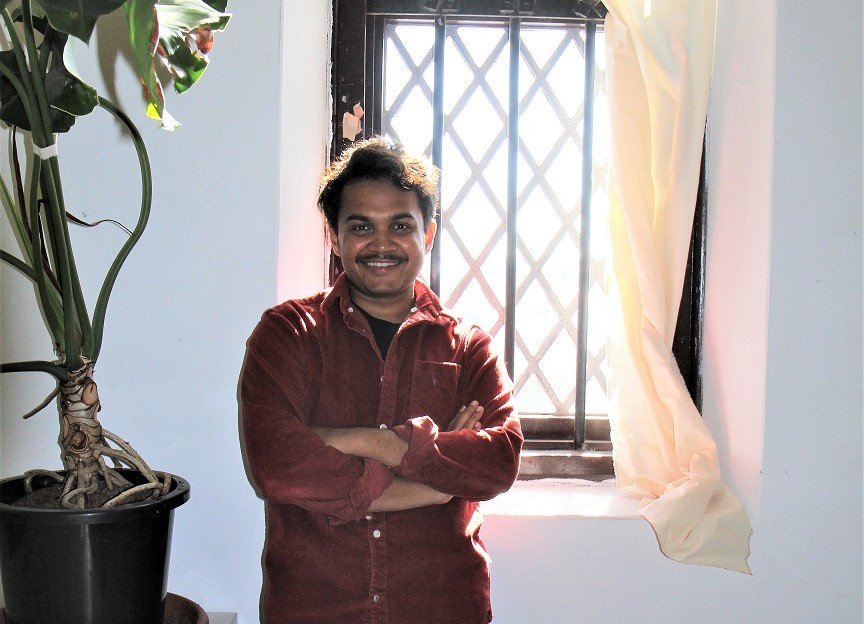
Jay Emmanuel in the Encounter studio space at Fremantle Arts Centre
Your methodology is rather unique in that you perform significant research and consultation with marginalized communities, such as your work with refugee communities for Children of the Sea. Can you tell me a bit more about this process?
The work Children of the Sea was not only made with the community, it was about the community and the community was also on stage. We didn’t have any blueprints for that process, there aren’t many theatre companies that are creating this kind of work. The process is very heavily based in community arts and cultural development (CACD) processes. It involves rigorous consultation, research and also building trust with community groups over many years.
The stories we present on stage are essentially derived from people in the community; where community becomes active creators in the process and our artistic decisions are influenced by those conversations. For Children of the Sea, we had people from the refugee community on stage, telling their stories. We aim to build this kind of porous relationship between Encounter and the community.
Encounter’s vision is to create a platform for diverse storytelling and foster a diverse theatrical workforce. What strategies are you employing to make this happen?
One of the biggest challenges of making the kind of work we make is the shortage of actors, performance devisers, musicians, composers and designers from ethnically diverse backgrounds. The workforce is incredibly limited. Even searching nationally and (sometimes) having the resources to bring cast and creatives from around the country, it is still limited. It speaks to a greater problem in the system.
Our approach to capacity development sprung from Children of the Sea, where we did a lot of skills development with young people. From that, there came this idea of doing a youth ensemble where the cast of Children of the Sea are paired with five more young people who are going through a program where they get upskilled in theatre making practitioners from WA and around the world. This time, we have Roslyn Oades who is a verbatim artist from Melbourne and Kelli McCluskey from PVI Collective to facilitate practice sharing, and also other practitioners who will offer their expertise. Coming soon, we have an emerging artist program to foster the skills of practitioners who already have some experience.
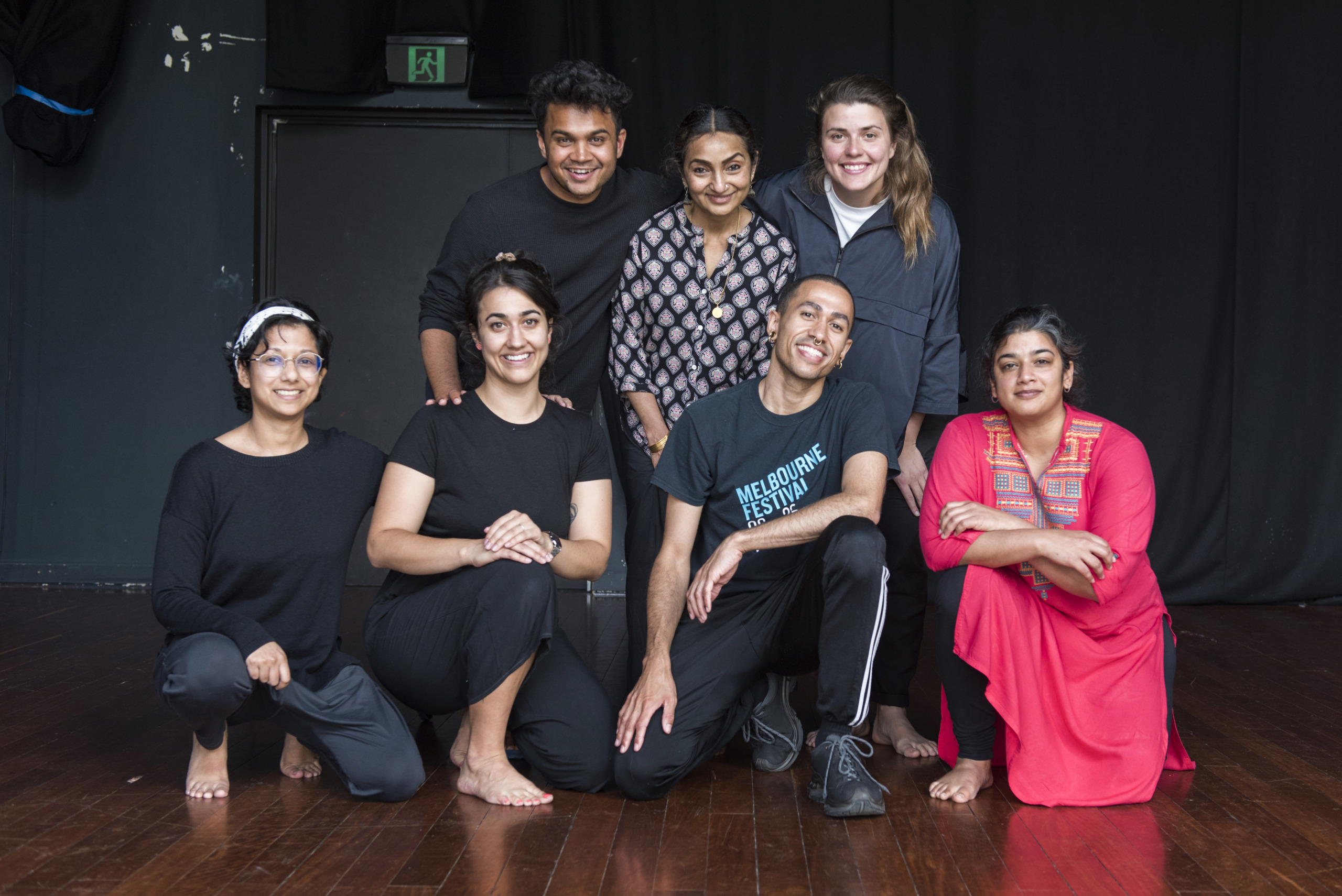
Encounter creative development team – back row L-R: Jay Emmanuel, Sukhi Shetty Krishnan, Emily Kingsley; front row L-R: Sunili Govinnage, Asha Kiani, Tyrone Earl Lraé Robinson, Manjula Radha Krishnan. Photo credit: Christophe Canato.
Your productions often meld together diverse cultural practices and traditions, such as Kathakali dance, which are not often seen in mainstream theatre. Why is this approach so important to you?
Nurturing a diverse workforce is our number one priority, but our second priority is diversifying the stories we see on stage and how these stories are told. Our mainstream audiences are accustomed to seeing realism, naturalism, Chekov and Shakespeare, but in the Asia Pacific region alone, there are writers and artists and forms of storytelling and puppetry that have been around for thousands of years. But why don’t we see them on stage? Encounter is focusing on reviving these practices and remembering that they exist, and creating that link where we can bring them into the popular culture.
For example, training to be a Kathakali dancer takes about 12 years, but here in Australia it’s not really recognized as a valid practice in mainstream training, it is just placed in a box of ‘community arts’. So what we’re trying to do is push for other forms and theories of storytelling to be given equal value. And that’s why I guess I always go to the community for inspiration, because I feel that’s where a lot of the storytelling with authentic power and prowess exists, rather than just feeding into the status quo.
What kinds of cultural practices have you been integrating into your performances?
For example, in the last three weeks we were in the development of a new project called Sunset (working title). The ethos of creation is driven by curiosity and experimentation. In this development we used Kalari which is an ancient form of Indian martial arts, about 3000 years old. We use it for actor training, because our work tends to be more physical and visual. We also have been experimenting with vogue. It’s the language of the queer community, and it’s how we have come to claim our history and express our history, but it’s rarely seen in the theatre. So we do go from very ancient practices like Kalari to more contemporary practices like vogueing. We’ve also worked with Bharatanatyam which is a South Asian form of classical dance and Indonesian shadow puppets. We explore a diverse cultural terrain in our work. It requires us to translate between cultures, and to find accessible ways of communicating ancient myths, practices and rituals for a contemporary audience.
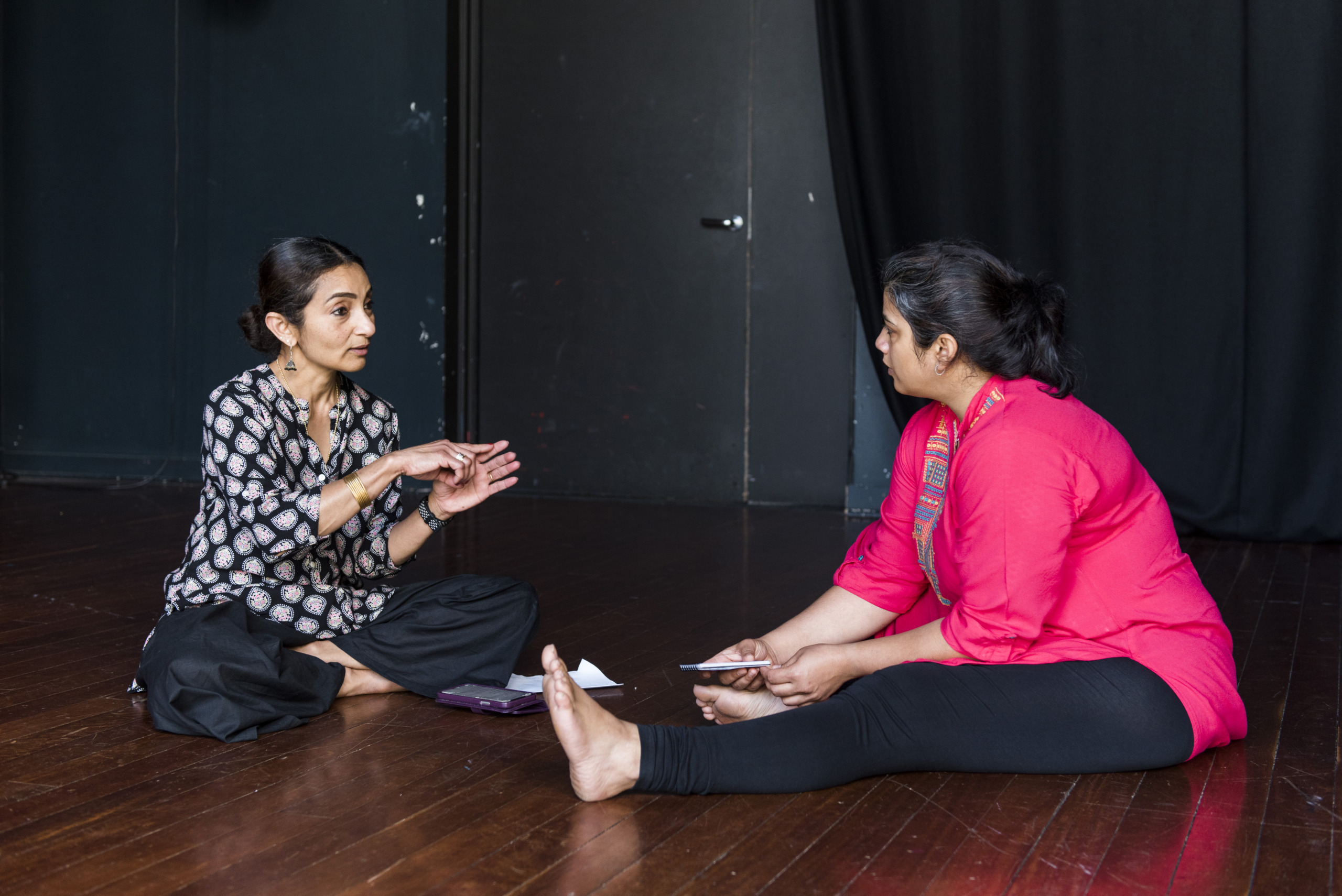
Encounter ensemble members Sukhi Shetty Krishnan and Manjula Radha Krishnan during a creative development workshop.Photo credit: Christophe Canato.
Encounter was launched at Fremantle Arts Centre in late 2021, and you’ve had a studio space here for almost six months. How are you finding it so far? What kind of activities has the space enabled?
This studio has been really instrumental as a place to gather. We are able to use it for script developments, script workshops and choreographic work, gatherings, donor events etc. Also, our associate artists – our core performers who we bring across all developments – can come and use the space as they like.
We’ve also used the Pavlich room for a couple of creative developments and workshops on devising, puppetry and vogueing. And of course, we had the launch of Encounter Theatre there some months ago. It’s been really great to use as a space to gather our supporters, a place where we can invite people to hear about our work.
Being situated at FAC also helps a lot because people recognize this place, they trust it. It’s an iconic Fremantle hub. Being surrounded by artwork in the galleries and working alongside studio artists from different disciplines is quite inspiring as well, on a conscious and sub-conscious level. I’ve had great conversations with other artists in the grounds. It’s really become the home for our company here.
Support the work of Encounter by contributing to their Australian Cultural Fund donor drive.
